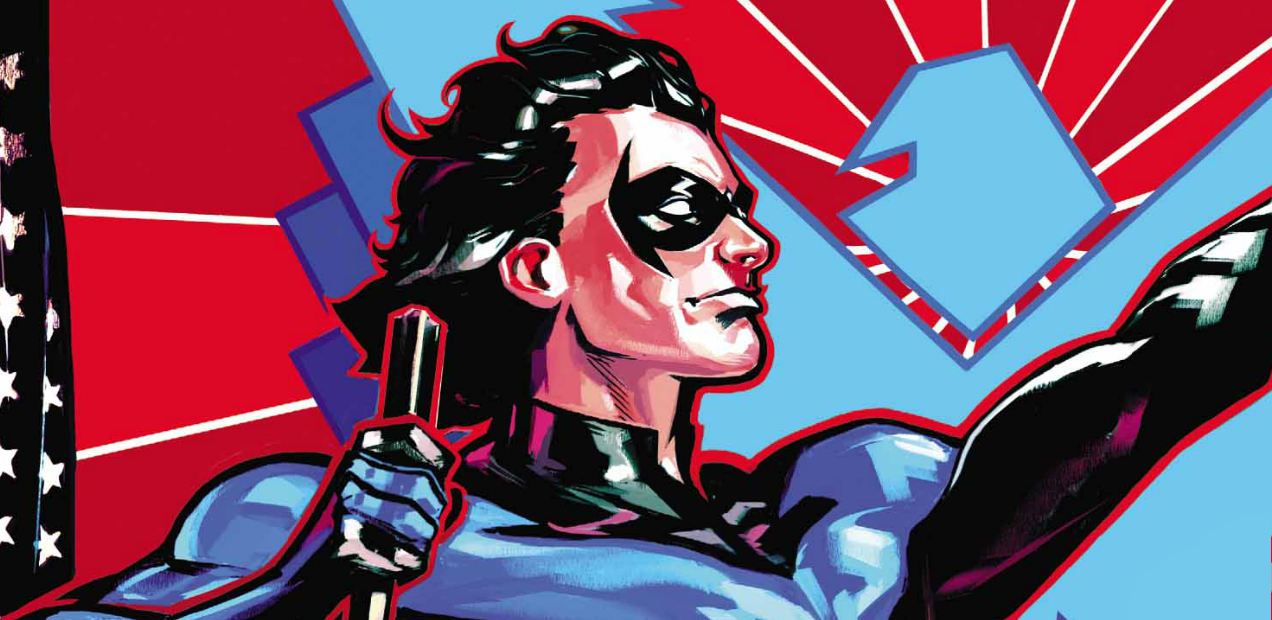By Jarrod Jones. Here’s something I never thought I’d see: Dick Grayson, Authoritarian. Goose Stepper. I always had him pegged as a rebel, the cool older brother. The guy with the shaggy hair and the sexy scars and the eternal mid-distance stare that said his mind was on something else. In Nightwing: The New Order, an Elseworlds-type “what if” from the Gates of Gotham creative team, we perceive Dick Grayson as something he fundamentally is not: a government stooge. Hang in there.
There are glimpses of the Dick we used to know in this futuristic worst-case scenario. He’s still charming (Dick shares quippy back-and-forths with his subordinates — yes, he has subordinates); he’s still seemingly absent-minded (he forgets he’s having a special guest over for dinner); and, especially with hints of grey forming at his temples, he’s still devastatingly handsome.
However. Considering what this character has done to his former superheroic mentors and comrades-in-arms (off-panel, at least for now), and considering the prickly fellow he’s become, it’s damn near impossible to like him. I mean, this year hasn’t exactly been bereft of clean-shaven fascists, either on the comics page or off of it.
The fact that Dick Grayson is the poster boy for an authoritarian regime might give some folks pause as to whether they’ll read The New Order or not. And I can’t say I’d blame them if they decided not to.
Dick’s heel turn is shocking, because it’s supposed to be. Nightwing can’t just step over the bodies of the Justice League if push came to superpowered shove, not without one hell of an ace in the hole. Because Dick Grayson isn’t Batman, and he never was. (Even when he tried to be.) That paranoid, “I’ve got my eye on you” mentality Bruce Wayne had in abundance was never a character trait that I’d associate with Dick Grayson.
The reasons behind his change of heart (not to mention his ethos) might have something to do with the fact that he’s a father now. It might have something to do with the fact that the members of his former family — the one that dwelled underneath Wayne Manor and Titans Tower — are either scattered to the winds, obligated to cleaning up a mess he made, or both. Loss changes a person. In Nightwing: The New Order, Dick Grayson is just as susceptible to human frailty as any other.
In the opening sequence of issue #1, we watch Dick and a squadron of armor-plated thugs chase after a middle-aged fellow who hardly has the physical fortitude to outrun them, even if he does have superpowers. (We come to learn this is — or was — Dr. Light.) In The New Order, metahumans are outlawed, inhibited by state-mandated medications and put on a register. This outlaw, who only went off his meds because they were beginning to futz with his brain, can scarcely leap to his own safety while Dick glides through the air overhead with the greatest of ease.
There’s a disparity at play here, one that writer Kyle Higgins keeps at the fore of his story. (Higgins, you’ll recall, also had a crackerjack run on Nightwing during those New 52 days.) All the hints that the nature of this world is tenuous at best are always there, not to mention the hypocrisy too. (In fact, you’ll probably guess the big moral conundrum before the issue even arrives to it, something that the writer does not shy away from.) Higgins’ words guide us from page to page, propelled by melancholy and a sense of inevitability. The answers come later. For now, it’s enough that Higgins gives us a world we understand, even if we don’t necessarily want to like it.
Trevor McCarthy does the heavy lifting in this regard by rendering Dick as a man constantly tamping down on his impulses. In the action sequence mentioned above, Dick looks perturbed that he’s out in the field hunting people down, even if he is somewhat exhilarated to be leaping off rooftops once more. Later, in a quiet sequence that features a crucial member of the Bat-family, McCarthy underscores it with a fleeting moment of adversarial tension. Dick has changed, the world has changed, and nobody likes it — not even, it would seem, Dick Grayson.
Whether we’re in the midst of a chase sequence or a dinner scene, Dean White drapes the pages in hues of foreboding. When Dick arrives at home, the warmth of his house is drained somewhat with desaturated tans. When we’re presented with a staggering two-page spread of Gotham City as it exists in this world, White amps up the contrast between black and red. Through White’s diligence, this version of Gotham City bleeds, begging for change. When we’re home with the Graysons, where these people are supposed to be safe, there’s a feeling of dread lurking just off panel.
In The New Order, Dick Grayson leads a Gestapo-like crew called “Crusaders”, a telling hint of where the former Nightwing’s heart still lies. Though, once you remove the “caped” from the equation, all that remains is “crusaders”, and all the moral implications that go with it. Higgins and McCarthy have a genuine affection for Nightwing, which, as it turns out, is strongly evident in these pages. Come for the audacity. Stay for the sincerity.
DC Comics/$3.99
Written by Kyle Higgins.
Art by Trevor McCarthy.
Colors by Dean White.
Letters by Clayton Cowles.
8 out of 10















